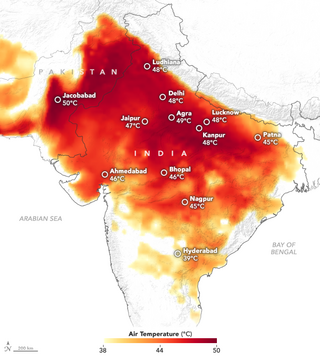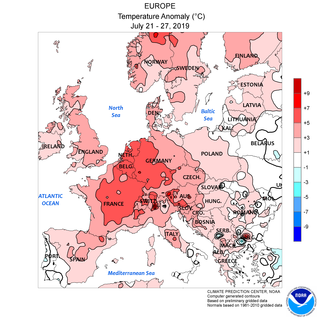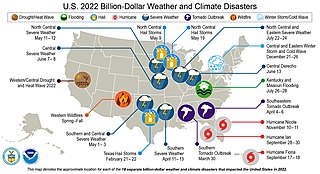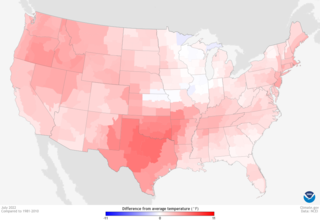
The 1896 eastern North America heat wave was a 10-day heat wave in New York City, Boston, Newark and Chicago that killed about 1,500 people in August 1896. [1] [2] [3]

The 1896 eastern North America heat wave was a 10-day heat wave in New York City, Boston, Newark and Chicago that killed about 1,500 people in August 1896. [1] [2] [3]
There were ten days of temperatures at least 90 °F (32 °C ) with high humidity and little breeze. [4] The temperatures in New York did not drop below 72 °F (22 °C ) at night, with three consecutive nights at 80 °F (27 °C ) or above. It killed more than the New York City draft riots and the Great Chicago Fire combined. [2] A majority of the deaths were of working-class men in their twenties who performed manual labor.
The New York City Public Works Commissioner ordered that his workers' shifts be modified so they would not be working during midday, and he had fire hydrants opened to cool people on the street. Theodore Roosevelt, then New York City Police Commissioner, distributed free ice from local police stations. After accidental deaths from people falling off the roofs they were sleeping on, the New York City Parks Department allowed people to sleep in parks overnight. [1] [2]

A heat wave, sometimes described as extreme heat, is a period of abnormally hot weather. High humidity often accompanies heat waves. This is especially the case in oceanic climate countries. Definitions vary but are similar. A heat wave is usually measured relative to the usual climate in the area and to normal temperatures for the season. Temperatures that humans from a hotter climate consider normal, can be regarded as a heat wave in a cooler area. This would be the case if the warm temperatures are outside the normal climate pattern for that area. Heat waves have become more frequent, and more intense over land, across almost every area on Earth since the 1950s. This is due to climate change.
The July 1995 Chicago heat wave led to 739 heat-related deaths in Chicago over a period of five days. Most of the victims of the heat wave were elderly poor residents of the city, who did not have air conditioning, or had air conditioning but could not afford to turn it on, and did not open windows or sleep outside for fear of crime. The heat wave also heavily impacted the wider Midwestern region, with additional deaths in both St. Louis, Missouri and Milwaukee, Wisconsin.
A rather cool and uneventful summer along the East Coast of the United States changed abruptly when a ridge of high pressure centered off the coast of South Carolina strengthened in late July.

The Summer 2006 North American heat wave was a severe heat wave that affected most of the United States and Canada, killing at least 225 people and bringing extreme heat to many locations. At least three died in Philadelphia, Arkansas, and Indiana. In Maryland, the state health officials reported that three people died of heat-related causes. Another heat related death was suspected in Chicago.

A cooling center is an air-conditioned public or private space to temporarily deal with the adverse health effects of extreme heat weather conditions, like the ones caused by heat waves. Cooling centers are one of the possible mitigation strategies to prevent hyperthermia caused by heat, humidity, and poor air quality.
A cold wave is a weather phenomenon that is distinguished by a cooling of the air. Specifically, as used by the U.S. National Weather Service, a cold wave is a rapid fall in temperature within a 24-hour period requiring substantially increased protection to agriculture, industry, commerce, and social activities. The precise criteria for a cold wave are the rate at which the temperature falls, and the minimum to which it falls. This minimum temperature is dependent on the geographical region and time of year.
The 2007 European heat wave affected most of Southern Europe and the Balkans. The phenomenon began affecting Italy and Turkey on 17 June and expanded into Greece and the rest of the Balkans, Hungary and Ukraine on 18 June. The costs of the heat wave were estimated at 2 billion euros.
The 2007 North American heat wave started at the end of July and lasted into the first weeks of August. It was associated with severe drought over regions of the southeastern United States and parts of the Great Lakes region.

The 2010 Northern Hemisphere summer heat waves included severe heat waves that impacted most of the United States, Kazakhstan, Mongolia, China, Hong Kong, North Africa and the European continent as a whole, along with parts of Canada, Russia, Indochina, South Korea and Japan during July 29 2010. The first phase of the global heatwaves was caused by a moderate El Niño event, which lasted from June 2009 to May 2010. The first phase lasted only from April 2010 to June 2010, and caused only moderate above average temperatures in the areas affected. But it also set new record high temperatures for most of the area affected, in the Northern Hemisphere. The second phase was caused by a very strong La Niña event, which lasted from June 2010 to June 2011. According to meteorologists, the 2010–11 La Niña event was one of the strongest La Niña events ever observed. That same La Niña event also had devastating effects in the Eastern states of Australia. The second phase lasted from June 2010 to October 2010, caused severe heat waves, and multiple record-breaking temperatures. The heatwaves began in April 2010, when strong anticyclones began to develop, over most of the affected regions, in the Northern Hemisphere. The heatwaves ended in October 2010, when the powerful anticyclones over most of the affected areas dissipated.

The 1911 Eastern North America heat wave was an 11-day severe heat wave that killed at least 380 people, though estimates have put the death toll as high as 2,000 people. The heat wave began on July 4, 1911 and didn't cease until July 15. In Nashua, New Hampshire, the temperature peaked at 106 °F (41 °C). In New York City alone, 158 people and 600 horses died.
The 2011 North American heat wave was a deadly summer 2011 heat wave that affected the Southern Plains, the Midwestern United States, Eastern Canada, the Northeastern United States, and much of the Eastern Seaboard, and had Heat index/Humidex readings reaching upwards of 131 °F (55 °C). On a national basis, the heat wave was the hottest in 75 years.

The Summer 2012 North American heat wave was one of the most severe heat waves in modern North American history. It resulted in more than 82 heat-related deaths across the United States and Canada, and an additional twenty-two people died in the resultant June 2012 North American derecho. This long-lived, straight-line wind and its thunderstorms cut electrical power to 3.7 million customers. Over 500,000 were still without power on July 6, as the heat wave continued. Temperatures generally decreased somewhat the week of July 9 in the east, but the high pressure shifted to the west, causing the core of the hot weather to build in the Mountain States and the Southwestern United States shifting eastwards again by mid-July. By early August, the core of the heat remained over the Southern Plains.
The 2018 North American heat wave affected regions of Canada, where at least 70 deaths in Quebec were heat-related, the United States, where 18 states between Michigan and New Mexico issued heat advisories to a population of over 60 million people, and of Mexico, particularly the northwest and central regions.

From mid-May to mid-June 2019, the republics of India and Pakistan had a severe heat wave. It was one of the hottest and longest heat waves in the subcontinent since the two countries began recording weather reports. The highest temperatures occurred in Churu, Rajasthan, reaching up to 50.8 °C (123.4 °F), a near record high in India, missing the record of 51.0 °C (123.8 °F) set in 2016 by a fraction of a degree. As of 12 June 2019, 32 days are classified as parts of the heatwave, making it the second longest ever recorded.

In late June and late July 2019 there were two temporally distinct European heat waves, which set all-time high temperature records in Belgium, France, Germany, Luxembourg, the Netherlands, and the United Kingdom.

The following is a list of weather events that occurred on Earth in the year 2022. The year began with a La Niña. There were several natural disasters around the world from various types of weather, including blizzards, cold waves, droughts, heat waves, wildfires, floods, tornadoes, and tropical cyclones. The deadliest weather event of the year were the European heat waves, which killed over 26,000 people, 11,000 of which were in France. The costliest weather event of the year was Hurricane Ian, which caused at least $112.9 billion in damages in Florida and Cuba. Another significant weather event was the Pakistan floods, which killed 1,739 people and a total of $14.9 billion in damages.

In 2022, several areas of the world experienced heat waves. Heat waves were especially notable in East Asia, the Indian subcontinent, Australia, western Europe, the United States, and southern South America. 2022 heat waves accounted for record-breaking temperatures and, in some regions, heat-related deaths. Heat waves were worsened by the effects of climate change, and they exacerbated droughts and wildfires.

The environment of New York City consists of many interwoven ecosystems as part of the New York–New Jersey Harbor Estuary. The climate of New York City shapes the environment with its cool, wet winters and hot, humid summers with plentiful rainfall all year round. As of 2020, New York City held 44,509 acres of urban tree canopy with 24% of its land covered in trees. As of 2020, the population of New York City numbered 8.8 million human beings.

From late spring to late summer heat waves in 2022 smashed many records in North America between May and September of that year. Dozens of temperature records were surpassed in the United States.